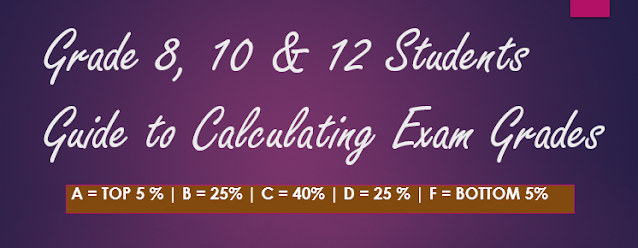When students are anticipating Grades 8, 10 or 12 examinations (and results or selections) it is perhaps useful to estimate their marks. This post aims to show parents, students, teachers and stakeholders how to estimate the grades of students.
 |
| Percentage based grading - an example |
There are two benefits of knowing the likely grades of students - and especially the grade 12 students - before they sit the national exams based on percentages ranking (shown below).
- Firstly, this will help students to revise well and teachers to prepare their students properly for examinations.
- Secondly, this can help students to make suitable choices on School Leavers Forms (SLF).
Exam & School-based Test Results
Suppose the total marks in an 'external' examination is out of 100 marks, a student who sits the exam can get a mark ranging from 0 to 100. The student is then graded accordingly. The final grading takes into account the student's performances in both the external examination and internal school-based tests/assessments for that particular subject.
The collating of marks is called Standardisation. This stage uses the student's MARKS from both the external (exam marks) and internal (school-based) performance results. Usually, the internal marks have less weight than the external marks.
The examinations are very important. The student will not be graded or go through the selection process if they do not sit the national examinations. Therefore as mentioned, exam plays a crucial part in the standardisation of student's marks. And, eventually selections to higher institutions.
In retrospect, exactly how the standardisation of results (and percentage composition of Internal vs external marks) in PNG is done is NOT available in the public domain. But, general inferences of marks and grading can put students in better positions. Especially, in a great position to prepare for exams and make informed choices on SLF.
So far, the post places emphasis on external exam performance. Yes, an exam is important in all scheme of things. In fact, exams results are the culmination of all the work that has been done over time, at different grade levels. The exams marks are barely the reflection of school-based learning.
The collating of marks is called Standardisation. This stage uses the student's MARKS from both the external (exam marks) and internal (school-based) performance results. Usually, the internal marks have less weight than the external marks.
The examinations are very important. The student will not be graded or go through the selection process if they do not sit the national examinations. Therefore as mentioned, exam plays a crucial part in the standardisation of student's marks. And, eventually selections to higher institutions.
In retrospect, exactly how the standardisation of results (and percentage composition of Internal vs external marks) in PNG is done is NOT available in the public domain. But, general inferences of marks and grading can put students in better positions. Especially, in a great position to prepare for exams and make informed choices on SLF.
So far, the post places emphasis on external exam performance. Yes, an exam is important in all scheme of things. In fact, exams results are the culmination of all the work that has been done over time, at different grade levels. The exams marks are barely the reflection of school-based learning.
Percentage-based Grading
The example of the breakdown in marks below can help you rationalise how the process works. Note that this is for guidance purposes onlyFor example, in Maths B a student's grades could be awarded on a percentage-based criteria as follows:
A = top 5 %
B = 25%
B = 25%
C = 40%
D = 25%
F = bottom 5%
So if a student wants to get an A in the Maths B exam (out of 100 marks) they MUST score 95/100 or more in the examination.
Schools Overestimating Internal Marks
There is always the temptation for schools to manipulate student's internal marks. Such practise should not be encouraged. It had little or no effect on student's overall performances and grading. It does the student no good.Schools must record students marks (and estimates where a student missed tests) according to the student's performance.
In reality, if a student combines this 'guesstimate with the Internal School Assessment result, he/she will be in a better position to revise well prior to the exams and also make an informed choice on the SLF.
If you have any questions or find this post useful, please leave a message at the bottom and I'll respond in due course.


